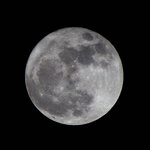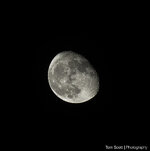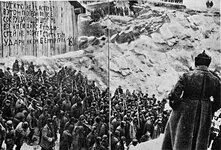You are using an out of date browser. It may not display this or other websites correctly.
You should upgrade or use an alternative browser.
You should upgrade or use an alternative browser.
Spring/Summer 2013 image thread
- Thread starter tomscott
- Start date
No it doesn't. If the image isnt sharp to start with and is muddy PP doesnt help, if anything it has increased the colour fringing and colour noise, contrast adds unwanted colour and contrast edges doent help when an image is soft, neither does sharpening just makes the image noisy. But probably less sharp due to cropping and enlarging as well as shooting wide open with a 2x extender.
If you compare the details. 400 with a 2x and a 400 naturally.

SuperMoon by stuart.truman, on Flickr

Moon, Largest in 18 years by TomScottPhoto, on Flickr
Its due to using a 2x extender wide open at 5.6. If a lens is a 2.8 putting a 2x extender on it doubles the effective aperture so you have a 200-400mm F5.6 lens. Stopping it down helps but obviously reduces your shutter speed needed to freeze the moon so you have to bump up the ISO to compromise. Unfortunately sharpening and edge contrast like clarity doesn't really help. Not saying its wrong its just a trait and on a full frame camera is more pronounced.
Like I said its hard shooting the moon without kit that out of reach for 99% of people.
600mm lenses are over 10k 400mm F2.8 are 6k. More than most E85s.
If you compare the details. 400 with a 2x and a 400 naturally.

SuperMoon by stuart.truman, on Flickr

Moon, Largest in 18 years by TomScottPhoto, on Flickr
Its due to using a 2x extender wide open at 5.6. If a lens is a 2.8 putting a 2x extender on it doubles the effective aperture so you have a 200-400mm F5.6 lens. Stopping it down helps but obviously reduces your shutter speed needed to freeze the moon so you have to bump up the ISO to compromise. Unfortunately sharpening and edge contrast like clarity doesn't really help. Not saying its wrong its just a trait and on a full frame camera is more pronounced.
Like I said its hard shooting the moon without kit that out of reach for 99% of people.
600mm lenses are over 10k 400mm F2.8 are 6k. More than most E85s.
I'm not saying for a second it's anywhere near as good as doing it the correct way in the photographing stage, what I'm saying is a shot isn't always ruined if it's not quite right initially and there's alot you can do in PP to bring out the details of what you've captured. I did that in <25 seconds but if I were to take the original full size image of Stuarts and spend maybe half an hour I could get it sharp, defined and virtually no noise.
IMO of course.
IMO of course.
Trouble is when it's post processed, it just looks wrong! That's not how the moon looks to us.
I think certain photo's should capture what we can see with our eyes/telescope/binoculars. The 2nd pic Tom has put on looks more realistic because he captured what can be seen.
This is why I get so aggravated over photoshopping stuff.
If someone hasn't got the equipment or know how to take a shot like Tom's then take the best shot you can and minor post processing is ok but not so it gets distorted into something that's not recognisable as something we know.
(Obviously that's not unless you are aiming for a full on 'arty' image)
I think certain photo's should capture what we can see with our eyes/telescope/binoculars. The 2nd pic Tom has put on looks more realistic because he captured what can be seen.
This is why I get so aggravated over photoshopping stuff.
If someone hasn't got the equipment or know how to take a shot like Tom's then take the best shot you can and minor post processing is ok but not so it gets distorted into something that's not recognisable as something we know.
(Obviously that's not unless you are aiming for a full on 'arty' image)
Ye that goes without saying, raw is so powerful you can create miracles with it. But when it comes to sharpeness if an images isnt sharp due to lens traits or technique or the subject moving there is pretty much nothing you can do.
Although the new PS CC has a tool that you can make blured images from camera shake sharp which looks pretty cool!
[youtube]66yKdIXMAu8[/youtube]
Although the new PS CC has a tool that you can make blured images from camera shake sharp which looks pretty cool!
[youtube]66yKdIXMAu8[/youtube]
Yeah that was a bad and rushed example, the point I was making is that often alot of the detail and definition is there in an image it just may not be visible to the naked eye to due bad exposure or whatever.
It's more a point about definition and detail rather than sharpness, you're right that a blurred image is hard to bring round (though not undo-able with time).
Here's another rushed example, grabbed the first image of google. A perfectly good shot but lets pretend they wanted something with a bit more definition and liveliness to it:

20 seconds in photoshop and i've brought out the detail. Again a bit of noise I've not cleaned up because i didn't spend long on it and it's a bit overly done to exaggerate my point but it shows that sometimes the detail and texture IS there in a shot, just not fully brought out.

It's more a point about definition and detail rather than sharpness, you're right that a blurred image is hard to bring round (though not undo-able with time).
Here's another rushed example, grabbed the first image of google. A perfectly good shot but lets pretend they wanted something with a bit more definition and liveliness to it:

20 seconds in photoshop and i've brought out the detail. Again a bit of noise I've not cleaned up because i didn't spend long on it and it's a bit overly done to exaggerate my point but it shows that sometimes the detail and texture IS there in a shot, just not fully brought out.

Carol M said:Ste, I prefer the first image. The 2nd one isn't realistic and that's what I don't like. Just my personal opinion of course. What do I know? :lol:
Hence the "lets pretend they wanted something with a bit more definition and liveliness to it" and "it's a bit overly done to exaggerate my point" 8)
Well it depends what you want really because if your shooting raw it will be flat and need to be processed to be seen. Depends on your preference of editing I like to make my images look true to life with possible some colour correction, sharpening and removing distracting elements.
But you can go way overboard but its a learning curve, ive been retouching for 13 years and I create an image then a week later I will look at it and think FFS. Like the image in my sig the vignette looks ridiculous on the full image.
The camera is a biased tool you cannot trust a photographic image because the photographer shows you what he sees, it can distort reality without editing, make situations look much worce than they are. War an propaganda imagery is a perfect example. Image manipulation has been ongoing since 1870, you can do everything in a darkroom you can with PS just takes longer and more skill. Different chemicals, drawing on negatives, merging negs etc
A good example is if you look at original Ansel Adams prints, his original first images from the darkroom were god awful compared to the when the master printers got hold of them.
This rodchenko image
original image

photomontage

Photo montage is basically the first Photoshop, first popularised by Rodchenko, he cut, paste, retouched and created new energetic images out of single photos.
This effect can be harnessed for good or for worst, such as the white sea canal edition of USSR in construction.
The top image is the original and below is the photo montaged image. The story goes they are criminals, being rehabilitated by hard labour digging a 140 mile canal but in reality they were political prisoners who died digging it out. The most saddening part I think is Rodchenko changed the skeleton like faces of the prisoners to healthy smiling faces…
This was 1933. Its been going on for a long time.
But you can go way overboard but its a learning curve, ive been retouching for 13 years and I create an image then a week later I will look at it and think FFS. Like the image in my sig the vignette looks ridiculous on the full image.
The camera is a biased tool you cannot trust a photographic image because the photographer shows you what he sees, it can distort reality without editing, make situations look much worce than they are. War an propaganda imagery is a perfect example. Image manipulation has been ongoing since 1870, you can do everything in a darkroom you can with PS just takes longer and more skill. Different chemicals, drawing on negatives, merging negs etc
A good example is if you look at original Ansel Adams prints, his original first images from the darkroom were god awful compared to the when the master printers got hold of them.
This rodchenko image
original image

photomontage

Photo montage is basically the first Photoshop, first popularised by Rodchenko, he cut, paste, retouched and created new energetic images out of single photos.
This effect can be harnessed for good or for worst, such as the white sea canal edition of USSR in construction.
The top image is the original and below is the photo montaged image. The story goes they are criminals, being rehabilitated by hard labour digging a 140 mile canal but in reality they were political prisoners who died digging it out. The most saddening part I think is Rodchenko changed the skeleton like faces of the prisoners to healthy smiling faces…
This was 1933. Its been going on for a long time.
tomscott said:Depends on your preference of editing I like to make my images look true to life with possible some colour correction, sharpening and removing distracting elements.
I suppose the difference is you're a photographer first and foremost (and a very good one at that) whereas I'm a digital designer more on the creative art side. I like things to be overdone, and to tell a story or bring out a theme in the PP whereas you do it through the initial shot. Horses for courses I guess, depends on each individual shot and what you're trying to do.
And out and out photomanipulation is a different thing all together. We both could make it look like someone was driving a Z on the moon if we wanted, as opposed to how to bring out what we want a photo of the moon to "say" about it.
Like you Ste I work as a graphic designer but also as a photographer for a newspaper company. I do equal amounts of both but see more and process more images than I take.
All images need PP or they would be flat and not very aesthetically pleasing, and would be rejected by media without it. The digital camera was designed for PP when you camera clicks and converts the image to a jpeg that is a type of post processing depending on how you have your camera render jpegs, low or high contrast high or low saturation etc so it may not look like the scene anyway. Same with raw, raw has to be processed to get the image out of the data you can't just print it.
Pp is necessary unless you use huge million pound cinematic lighting rigs and close off roads Etc like gregory crewdson does. But even then they are scrutinised over. In one of his images the street lights weren't the right temperature for his film so they had to be turned off and added back in post production... Completely transforming the scene.
Same with all of Gurskys images. They are all manipulated.
All images need PP or they would be flat and not very aesthetically pleasing, and would be rejected by media without it. The digital camera was designed for PP when you camera clicks and converts the image to a jpeg that is a type of post processing depending on how you have your camera render jpegs, low or high contrast high or low saturation etc so it may not look like the scene anyway. Same with raw, raw has to be processed to get the image out of the data you can't just print it.
Pp is necessary unless you use huge million pound cinematic lighting rigs and close off roads Etc like gregory crewdson does. But even then they are scrutinised over. In one of his images the street lights weren't the right temperature for his film so they had to be turned off and added back in post production... Completely transforming the scene.
Same with all of Gurskys images. They are all manipulated.
Similar threads
- Replies
- 14
- Views
- 527











